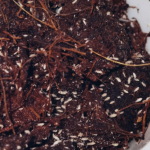

Carebara melasolena
60,00€
Scientific Name: Carebara melasolena
Taxonomic Classification: Kingdom Animalia, Phylum Arthropoda, Class Insecta, Order Hymenoptera, Family Formicidae, Subfamily Formicinae, Genus Carebara.
Geographic Distribution: Carebara melasolena is found in various regions of Asia, including India, Sri Lanka, Myanmar, Thailand, and Vietnam.
Physical Characteristics: Carebara melasolena is a small ant, with an average length of about 2-3 mm. Its body is dark brown or black in color, with some individual variations. The workers have a robust body and a large head compared to the rest of the body.
Behavior: Carebara melasolena is a polymorphic ant, meaning there are castes with different sizes and functions within the colony. The workers are responsible for daily activities such as foraging for food, nest construction, and caring for the brood. These ants are known for their aggressiveness and their ability to defend against potential threats.
Conservation Status: There is no specific information available regarding the conservation status of this species.
Additional Notes: Carebara melasolena is commonly found in forests and shrub areas. They are generally omnivorous ants, feeding on small insects, flower nectar, and other organic materials. These ants form relatively small colonies, with the number of individuals varying depending on habitat conditions. Furthermore, it has been observed that Carebara melasolena is capable of establishing symbiotic relationships with aphids, benefiting from the honeydew they produce.
| Options |
Queen with 200-500 workers |
|---|
Related products
Camponotus pseudolendus
Sold out
Polyrhachis armata
Sold out
Camponotus turkestanus
Sold out
Oecophylla smaragdina
Sold out
Camponotus castaneus
Sold out
Camponotus fedtschenkoi
Sold out
Crematogaster Biroi (ant colony)
Sold out






















